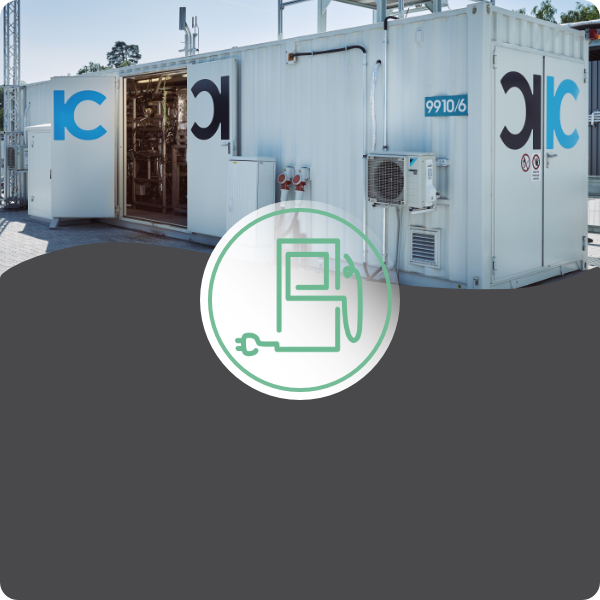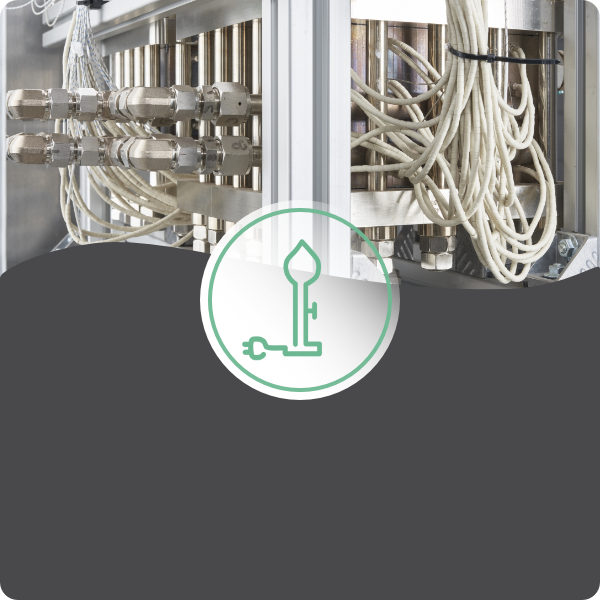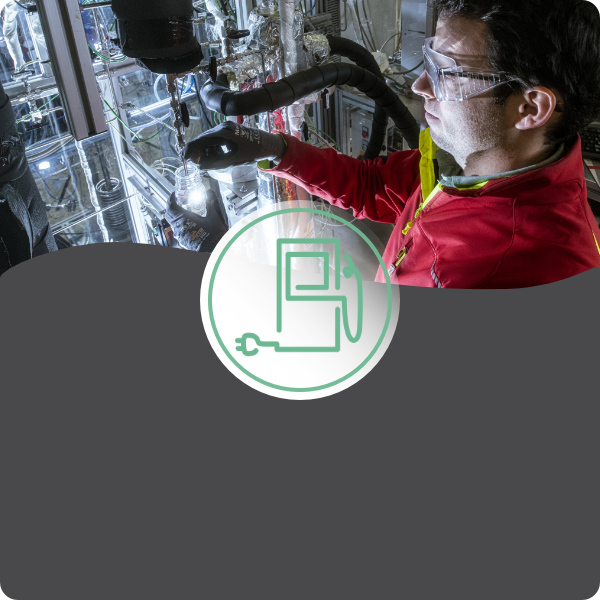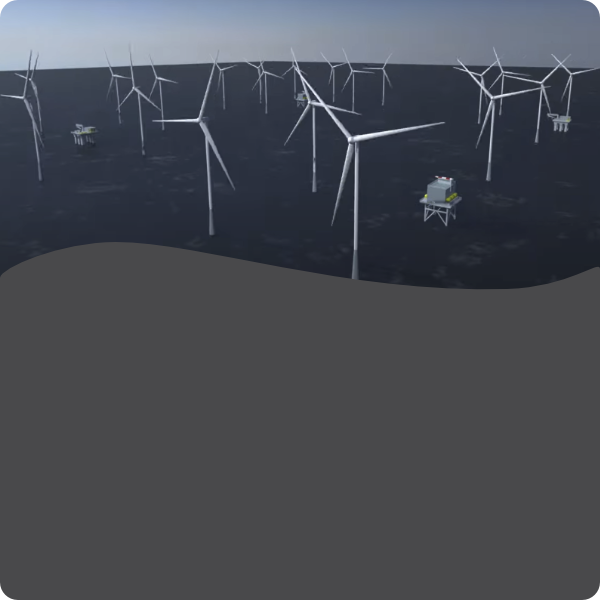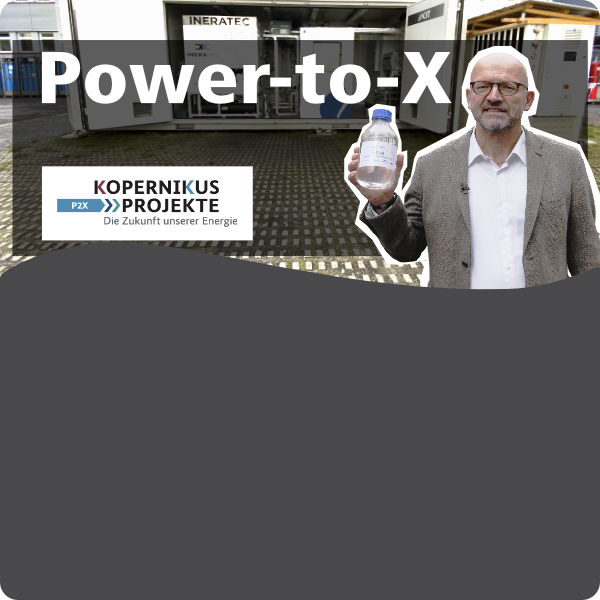Power-to-Liquid-Processes
sprungmarken_marker_613
Hybrid Processes for the Production of E-Methanol and Biomethane
Counteracting climate change is the challenge of the KIT spin-off ICODOS (Intelligent Carbon Dioxide Solutions). By means of a specially developed process, ICODOS produces biomethane and e-methanol from sewage sludge and biological waste. Of course, green electricity is used for the process.
Biogas is a carbon neutral source of energy and CO2. The carbon dioxide (CO2) it contains is first separated from it. In a combined process, this CO2 is converted into methanol together with green hydrogen (H2).
With the technology developed by ICODOS, it can be processed into high-quality biomethane. At the same time, green e-methanol can be produced from the resulting CO2. This is therefore a novel hybrid process that can save both energy and costs.
A major advantage of this process is that the product of methanol synthesis can be used as a solvent for CO2. It regenerates continuously along the way. Therefore, solvent degradation or loss does not reduce performance. This increases the service life of the plant and reduces maintenance requirements. In addition, the integration of the two processes reduces the number of instruments and interfaces. Thus, this unique combination of CO2 capture and methanol synthesis is the most efficient CO2 capture technology.
E-Fuels from Fischer-Tropsch-Synthesis
We must drastically reduce CO2 emissions in the transport sector. At the same time, we must ensure the global transport of goods and people, which is why we need a CO2-neutral form of mobility. But how?
Electromobility with power from renewable sources cannot be the answer to all concerns. Heavy transport, air traffic and shipping won't work without the high energy density of liquid fuels.
Therefore, liquid fuels are produced in the Energy Lab 2.0 according to the Power-to-Liquid (PtL or P2L) concept with electric power from renewable energy sources and CO2, up to 200 l per day. The carbon dioxide is taken directly or indirectly from the atmosphere. Therefore, the CO2, which is emitted at the end e.g. by ships, planes or trucks with the use of the so-called e-fuels, is taken from the air beforehand. Hence, the CO2 cycle is closed and the fuel is CO2-neutral.
To be able to produce the e-fuels from renewable electricity, water and CO2, several processes have to be interconnected to form a process chain. At the Energy Lab 2.0, researchers are investigating different process options and combinations. All the PtL process chains investigated include the following basic steps:
Step 1: Extraction of CO2 from the air or other non-fossil sources
On the one hand, carbon dioxide can be obtained from the exhaust gases of large-scale industrial processes, such as cement production, which releases the climate gas even if fossil fuels are no longer used. Otther source´s are waste incineration plants or biogenic sources such as biogas plants. And finally, CO2 can be filtered directly from the ambient air using so-called Direct Air Capture (DAC) processes. In such a process type, the air is passed over a special filter material or brought into contact with a special liquid on or in which the CO2 is selectively bound. As soon as the material or liquid is loaded with CO2, the bound CO2 is released again, for example by an increase in temperature, and, thus, can be recovered in pure form for the subsequent process step. Together with partners, this is investigated by KIT in various research projects at the Energy Lab 2.0.
In order to reduce the amount of energy spent on air movement during DAC, these systems can also be installed in large office complexes, supermarkets, and other buildings with air conditioning and ventilation technology. Many people or companies then collectively extract CO2 and convert it - in line with the crowd oil principle - into other fuels via the steps described below.
Step 2: Generation of synthesis gas via an electrolysis process and CO2
In the power-to-liquid conversion process, hydrogen from electrolysis plays the part of the universal energy carrier as an intermediate stage on the way to synthetic fuels. Green hydrogen can be produced by electrolysis of water (e.g. PEM electrolysis) or steam (solid oxide electrolysis) with green electricity. Both electrolysis technologies are available at Energy Lab 2.0. CO2 is a very inert molecule. Therefore, synthesis gas is required for the actual fuel synthesis in the third step of the process chain. Synthesis gas is the mixture of hydrogen and reactive carbon monoxide (CO). The synthesis gas can be produced from hydrogen - e.g. from the common PEM or steam electrolysis - and CO2 via a chemical reaction, the so-called reverse water gas shift reaction (RWGS for short). In this process, the carbon dioxide reacts with hydrogen to form carbon monoxide and water. You could say that you sacrifice part of the hydrogen for the carbon dioxide conversion. With the so-called co-electrolysis of steam and carbon dioxide, the synthesis gas can even be produced electrolytically from CO2 and steam directly in a single step. This variant is developed in the Kopernikus project "P2X" by KIT together with its partner Sunfire at Energy Lab 2.0. With PEM and steam electrolysis in combination with the RWGS reaction and co-electrolysis, the scientists at Energy Lab 2.0 thus have three options for synthesis gas generation at their disposal. In addition, the synthesis gas generated from biomass residues in the bioliq® process chain can also be used for fuel synthesis in the Energy Lab 2.0.
Step 3: Synthesis of fuel molecules from synthesis gas
Long-chain hydrocarbon molecules can be produced from synthesis gas using a process known as Fischer-Tropsch synthesis. These molecules are the essential components of e-fuels and chemically correspond to the molecules that are also contained in the fossil fuels we know today. The reaction itself was already developed in the 1920s by Franz Fischer and Hans Tropsch. A new feature of the Energy Lab 2.0 is the use of compact chemical reactors developed at KIT and commercialized by the KIT spin-off INERATEC GmbH. These reactors are microstructured on the inside, making them highly efficient, which also allows them to be used in a container-based plant, for example. In addition, the reactors have a modular design, which makes them easily scalable. The heat released during this reaction can be dissipated very well by these compact reactors, which means that not only can the reaction be controlled well, but the energy can also be used efficiently: In the Energy Lab 2.0, the released reaction heat is used in the form of steam at other points in the process chain, which increases the overall efficiency of the process chain. The products of the Fischer-Tropsch synthesis naturally exhibit a broad distribution of molecular chain length. Chain length is a significant factor in their suitability as a renewable version of the kerosene, diesel or gasoline we know today. The products of the Fischer-Tropsch synthesis can be divided into three ranges according to their molecular chain length: The molecules of medium chain length already represent the optimal starting materials for the liquid e-fuels and thus the target product. The molecular chains that are too short and therefore gaseous are reused within the process and thus led back into the generation of synthesis gas. The very long molecular chains are solid at room temperature - this is why they are also referred to as "waxes". These can be used as valuable products, e.g. in the chemical industry, but are not directly suitable as fuel - the chain length must first be reduced. This is done at Energy Lab 2.0 in the fourth and final step of the process chain.
Step 4: Product processing into e-fuel
In the last step of the process chain, the products are prepared and optimised. The aim is to modify the products directly after the Fischer-Tropsch synthesis so that they comply with the standard and can thus be used as fuel. This involves tailoring a wide range of chemical and physical properties. The chain length is optimised and branches are introduced into the hydrocarbon chains through so-called "hydrocracking and isomerisation". The former is done by splitting hydrocarbon molecules with excessively long chains (waxes). Thus, in this last process step, not only the product properties are optimised, but also the total fuel yield is increased since the product distribution is shifted into the optimal chain length range. Depending on the operating parameters and the catalysts used, kerosene, diesel or gasoline can be produced preferentially. This last process step is being implemented in the process chain at Energy Lab 2.0 as part of the reFuels research project.
With the PtL process chain facilities at Energy Lab 2.0, researchers now have the opportunity to answer a wide range of questions through experiments on a larger scale.
More about the process chains
Even though the individual steps of the described PtL process chain are well known and partly commercialized in the meantime, the Energy Lab 2.0 enters new territory with the implementation of these process chains on this scale. By linking the individual processes into an integrated process chain, many advantages can be derived. However, some practical questions can now be answered by the researchers. One focus of the work on power-to-liquid process chains at the Energy Lab 2.0 is the overall efficiency of the process chain: by cleverly combining the individual steps into an integrated process chain, synergy effects are to be used in the best possible way to achieve high efficiency, i.e. to store as much of the renewable electricity as possible in the PtL products (e-fuels) for later use. In addition, the facilities at the Energy Lab 2.0 can be used to determine the optimum operating parameters for the production of fuels that ultimately meet standards only relying upon regenerative methods. Another research and development focus is on the dynamic operation of the process chains. There is no doubt that renewable electricity will or must be the primary source of energy in the energy system of the future, but by its very nature, it cannot be generated continuously at a single location, since the weather, the time of day and the seasons determine the supply. To contribute to the stabilization of the power grid through PtL technologies (see also EGSAL@Energy Lab 2.0), the researchers in Energy Lab 2.0 are investigating how PtL process chains can be operated under dynamic operating conditions. All these questions are addressed in research projects such as reFuels, Kopernikus P2X or Powerfuel together with partners from industry and research.


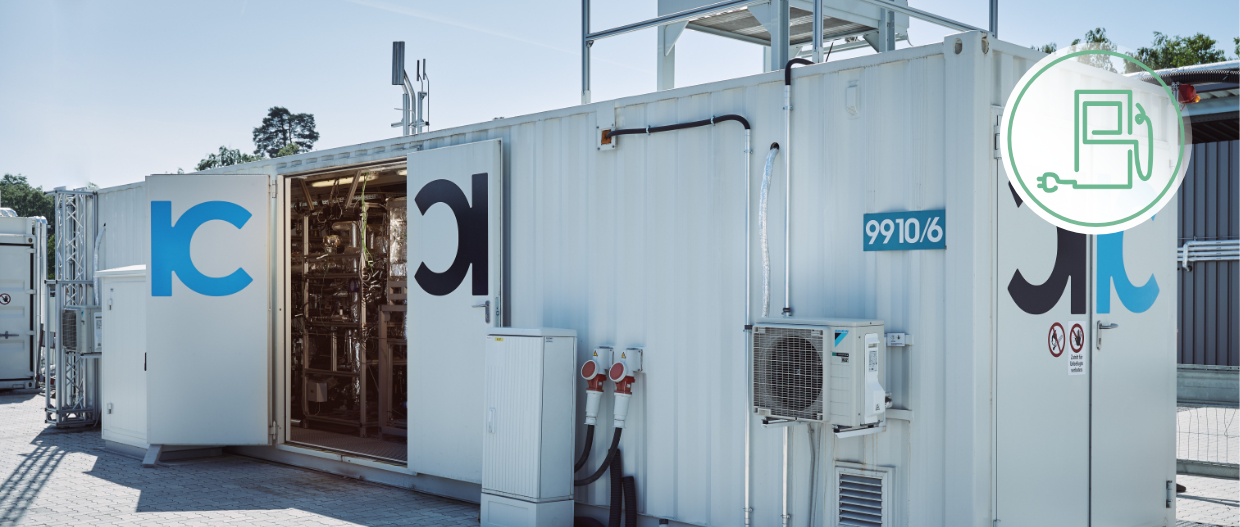



 324
324
